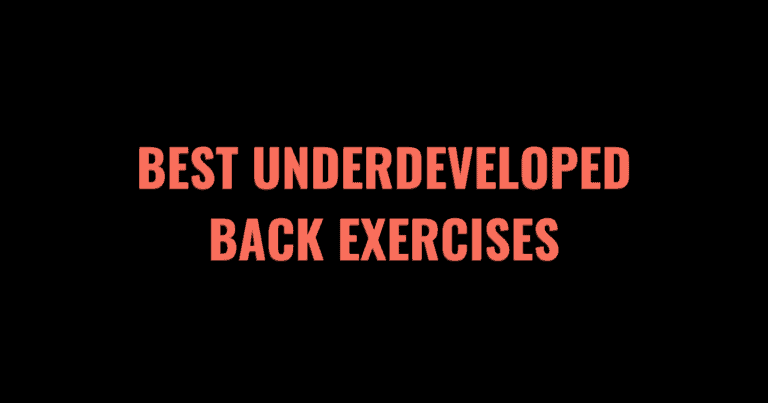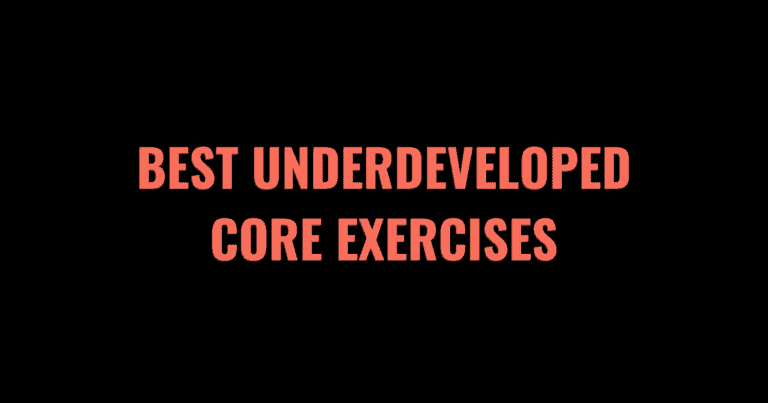Nearly everyone who steps foot in a gym aims to improve the size and definition of their arms. The arms are often considered to be the “show” muscles. Every time you ask someone to flex, more likely than not, they are going to flex their biceps. The biceps play an important role in physique sports because they are heavily judged.
For those who aren’t interested in aesthetics, the biceps are still important for performance and daily life activities. It’s quite common for strength/performance athletes, such as strongmen, powerlifters, Olympic weightlifters, and CrossFitters, to tear a bicep during an event because they don’t train them nearly enough.
Whether you’re looking to increase the size of your biceps or get them stronger to a bicep rupture, you’re in the right place! We’ve compiled a list of the best training tactics you can implement to improve underdeveloped biceps.
Keep reading to learn about the optimal rep ranges, bicep exercises, training volume, frequency, and intensity for bicep hypertrophy.
Table of Contents
- 1 What are underdeveloped biceps?
- 2 The 8 Best Ways to Grow Bigger Biceps
- 3 Perfect your exercise technique
- 4 The 10 best exercises for bicep growth
- 5 Bicep Anatomy
- 6 Bicep Hypertrophy FAQ
- 7 Closing Remarks
- 8 Grow Underdeveloped Muscle Groups
- 8.1 The 8 Best Ways to Strengthen Abs
- 8.2 The 7 Best Ways to Grow Underdeveloped Obliques
- 8.3 The 8 Best Ways to Grow a Bigger Back
- 8.4 The 8 Best Ways to Grow Bigger Shoulders
- 8.5 The 8 Best Ways To Grow a Bigger Upper Chest
- 8.6 The 8 Best Ways to Grow a Bigger Lower Chest
- 8.7 The 8 Best Ways to Build an Underdeveloped Core
- 8.8 The 8 Best Ways to Grow Bigger Upper Abs
- 8.9 The 8 Best Ways to Grow Bigger Front Delts
- 8.10 The 8 Best Ways to Grow Bigger Traps
- 8.11 The 5 Best Ways to Grow Bigger Triceps
- 8.12 The 8 Best Ways to Grow Bigger Hamstrings
- 8.13 The 7 Best Ways to Grow Bigger Rear Delts
What are underdeveloped biceps?
Underdeveloped biceps occur when the front part of the upper arm is noticeably weaker and/or smaller than surrounding muscles, such as the forearms, triceps, anterior delts, and chest.
Although the biceps are not a huge muscle, they contribute to at least half of the upper arm. Not to mention, they are often a focus in physique competitions. Additionally, weak biceps increase the risk of a tear or rupture.
The biceps mainly flex the arm, but they also assist the back muscles with various pulling exercises. The best way to improve weak biceps is by doing the proper amount of training volume, frequency, and intensity. You can also adjust your exercise selection, order, rep range, range of motion, elbow position, and time under tension.
If you want impressive-looking arms, try out some of the training tactics listed below!
The 8 Best Ways to Grow Bigger Biceps
- Perform the right amount of training volume
- Train your biceps more often
- Use the proper amount of intensity
- Perfect your exercise technique
- Work through a full range of motion
- Change your exercise order
- Increase time under tension
- Utilize a variety of rep ranges
Here are the 8 best ways to improve underdeveloped biceps:
Perform the right amount of training volume
One of the most important factors in gaining size and strength is performing the right amount of training volume per week and per session. If you do too much volume, you may hit a plateau, burn out, and potentially develop an overuse injury. On the other hand, if you do too little training volume, you won’t provide a strong enough stimulus for adaptation and growth.
Since the biceps are a smaller muscle group and are activated during other exercises, especially horizontal and vertical pulling movements, you don’t need to do as much direct bicep training. For most people, anywhere from 6-8 direct sets of bicep work is enough to prompt growth.
However, if you prioritize your biceps, you can do more volume as long as you can recover. The best approach to determining what training volume is right for you is to start a 4-6 week training block (mesocycle) with the minimum effective volume (MEV). From there, increase the number of sets you perform per week until you plateau, which is referred to as the maximum recoverable volume (MRV).
Here’s an example of what that would look like over a 4-week mesocycle with a 1-week deload:
- Week 1 – 6 sets divided between two bicep exercises
- Week 2 – 8 sets divided between two bicep exercises
- Week 3 – 10 sets divided between three bicep exercises
- Week 4 – 12 sets divided between three bicep exercises
- Week 5 – 4 sets divided between two bicep exercises (deload)
The deload is important for dropping the fatigue that has accumulated throughout the training block. As you increase your volume, increase your training frequency, which we will cover next!
Train your biceps more often
You have probably heard the saying, “every day is arm day.” While this is popular amongst gym bros who only care about how big their arms are, you shouldn’t be directly training them every day because they need time to recover. Unlike other bigger body parts, the biceps can be trained at a much higher frequency, up to 4-6 times per week. However, that doesn’t mean you have to train them that often to grow.
The sweet spot for bicep training frequency is somewhere between 2-4 times per week. The biggest advantage of increased training frequency is the ability to increase your weekly training volume.
Research suggests that doing more than 8-10 sets of a specific body part in a single training session is counterproductive. You’re much better off doing 5 sets of biceps on Monday and 5 sets of biceps on Thursday rather than all 10 sets in one day. Up to a certain point, the more often you train a muscle group, the more it will adapt, grow, and get stronger.
The more frequently you train a muscle group, the more important it becomes to use the proper amount of training intensity!
Use the proper amount of intensity
Similar to training volume and frequency, there’s an optimal level of intensity you should use for bicep hypertrophy. If you are always lifting to failure, you may not recover before the next session, and there’s a greater risk of injury. On the other hand, if you stop each set 4-5 reps from failure, you aren’t taxing the muscle enough to get it to grow.
Training intensity is defined as how many reps you are from technical failure. Unlike muscular failure, where you can’t move the weight another inch, technical failure is where you can’t perform another rep with proper form.
Since the biceps are a smaller muscle group and are mainly targeted through isolation exercises, training them to failure is safer. If you are working with high volume and frequency, stop 1-3 reps shy of technical failure.
Some strength athletes use percentages of their 1 rep max to determine training intensity, but that’s not very useful for the biceps since not many people are performing 1 rep max barbell curls. In terms of hypertrophy, it’s more practical to use a RPE (rating of perceived exertion) or RIR (reps in reserve) scale to determine training intensity.
Renaissance Periodization recommends starting a training cycle with 3 reps in reserve and lowering that as you progress through the weeks.
Here’s what that would look like:
- Week 1 – Stop 3 reps shy from technical failure
- Week 2 – Stop 2 reps shy from technical failure
- Week 3 – Stop 1 rep shy from technical failure
- Week 4 – Train to technical failure
- Week 5 – Stop 4 reps shy from technical failure (deload)
It’s important to perfect and standardize your exercise technique to assess your training intensity!
Perfect your exercise technique
EImproving your exercise technique is crucial to ensure you’re targeting the biceps by improving your exercise technique. It’s common for people to use momentum to curl the weight rather than by isolating the bicep. Although you can lift more weight and perform more reps using momentum, your biceps experience significantly less growtharen’t going to grow nearly as much.
Try reducing Dropping the weight and slowing down your tempo are two things you will likely have to do to improve your exercise form. Since the bicep is so close to the anterior delt, the front of the shoulder tends to take over the movement.
To combat this, make sure to keep your elbow locked at the side of your body and avoid swinging your upper arm forward as you curl. The only part of your arm that should movebe moving is your forearm at the elbow. Another thing to focus on is rotating your palm up (supination) to activate the bicep at the top of the movement.
If your primary goal is to grow your biceps, adjust your form accordingly to ensure you’re hitting the right muscle group. You will likely have to decrease the weight in the short term to improve your technique, but you will have more growth in the long term.
Work through a full range of motion
Doing each rep with a full range of motion is key for maximizing the muscle-building stimulus. Performing half reps is quite common with arm training because people use much more weight than they can handle. While dDoing half-reps may look cool on social media, but they will not lead to more growth in the long term.
Using a full range of motion will allows you to increase the amount of tension that’s placed on the bicep. Since the biceps are smaller muscles, it’s important to find ways to isolate them by altering elbow positioning and working through a full range of motion.
Regardless of what type of bicep curl variation you are doing, make sure the forearm is performing full extension and full flexion. It’s also important to note that the bicep performs wrist supination. At the top of each rep, focus on twisting your pinky so that it’s higher than your thumb.
Change your exercise order
Although exercise order isn’t as important as volume, frequency, intensity, and technique, it can be manipulated to emphasize specific muscles. An effective strategy for improving a lagging body part is training that muscle at the beginning of a workout. Normally, people perform bicep exercises at the end of a workout when they’re already quite fatigued.
An easy way to get your biceps to grow is by simply training them earlier in the workout when you’re fresh. This allows you to lift more weight, train at a higher intensity, and ensure that you don’t skip out on them at the end of the session. So instead of doing rows and pulldowns first, start the workout with barbell curls and incline dumbbell curls.
Furthermore, if you start to train your biceps more frequently, you can easily start any training session with a few bicep exercises. Since most bicep exercises aren’t very fatiguing, they will likely not negatively impact the performance of other muscle groups.
Increase your time under tension
Exercise tempo, also known as time under tension (TUT), refers to the rate at which an exercise is performed. The tempo is commonly prescribed as a 4-digit code, such as 4-0-2-0. Each number represents a specific portion of the lift. The four portions of an exercise include the eccentric (lowering), bottom, concentric (lifting), and top.
If your exercise program states that you should perform a dumbbell bicep curl with a 4-0-2-1 tempo, here’s what that would look like:
- It should take you ~2 seconds to lift the weight.
- You should pause at the top of the rep for ~1 second.
- It should take you ~4 seconds to lower the dumbbell back to the starting position.
- You should not pause at all at the bottom of the rep.
In regards to hypertrophy, a lot of exercises should be performed with a slow and controlled eccentric, a slight pause at the top of each rep, and an explosive concentric. In other words, you try to lift the weight as fast as possible, squeeze the target muscle at the top, and control the weight on the way down. Having the proper exercise tempo is key for muscle growth and injury prevention.
Utilize a variety of rep ranges
Varying your rep ranges is another effective training tactic you can implement to further encourage muscle growth. Every muscle group is composedcomprised of fast and slow-twitch muscle fibers.
Fast twitch muscle fibers are larger, more responsive to hypertrophy, and get activated the most when performing high-intensity, explosive movements. Slow twitch muscle fibers are smaller, less responsive to hypertrophy, and get activated during moderate-low intensity movements.
A sprinter versus a marathon runner is the best example of fast versus slow twitch muscle fibers. Sprinters are usually bigger, more muscular, explosive, and fast, but they don’t have very good stamina or endurance. Marathon runners are generally usually smaller, leaner, and can keep a pace for an extended period.
Although fast-twitch muscle fibers are more responsive to hypertrophy, all muscle fiber types have the ability to grow. PSo performing a variety of rep ranges is ideal for optimal growth. Every 4-6 weeks, switch up your rep range for the biceps. Start out with 6-8 reps, then try out 10-15, followed by 20-30 reps. You will stimulate bicep hypertrophy if you are training close enough to failure.
The 10 best exercises for bicep growth
Here are the top 10 bicep exercises for bigger and stronger biceps!
- Barbell Curls
- Cable Curls
- Dumbbell Curls
- Dumbbell Hammer Curls
- Spider Curls
- Incline Dumbbell Curl
- EZ Bar Curls
- Preacher Curl
- Concentration Curls
- Machine Curls
For more information on the best biceps exercises, check out these articles!
The 8 Best Short Head Dumbbell Exercises
The 8 Best Long Head Dumbbell Exercises
Bicep Anatomy
The bicep is positioned on the front of your upper arm. As the name suggests, the bicep has two components–the long and short head. The long head is placed outside your upper arm, whereas the short head is on the inside. The long head is also known as the bicep peak because it makes up the height of the bicep. The short head adds to the overall width or thickness of the upper arm.
The bicep is considered to be a biarticular muscle because it crosses two joints – the elbow and the shoulder. The primary actions of the bicep are elbow flexion, wrist supination, and shoulder flexion. Although it’s impossible to independently isolate one head of the bicep heads, you can emphasize one or the other by performing different bicep curl variations. In general, you want to perform exercises with your elbows at your side to target more of the long head.
To activate more of the short head, you will want to perform exercises with your elbows in front of your body. For more information on how to emphasize the short or long head, check out the articles listed above!
Bicep Hypertrophy FAQ
How often should you train your biceps?
The ideal training frequency for bicep hypertrophy is somewhere between 2 and 6 times per week. The more training volume you perform, the more times you should hit that muscle. As we mentioned before, doing more than 8-10 sets in a training session for a muscle group isn’t ideal. It’s better to perform 4-5 sets on Monday and 4-5 sets on Friday.
Your training frequency is ultimately dependent on your training schedule. YIn general, you shouldn’t train a muscle group on consecutive days to allow for recovery. However, the biceps are a smaller muscle group and may be able to recover faster.
What’s the ideal training intensity for bicep hypertrophy?
Regardless of your exercise or rep range, focus on it’s ideal to training near technical failure. Stopping a set more than 4 reps from failure may result in subpar hypertrophy. On the other hand, always training to failure and beyond may cause injury and inhibit adaptation.
Leaving 1-3 reps in the tank for each set is ideal for most people. With that said, the biceps are a smaller muscle group that’s primarily trained with isolation movements, so it’s much safer to train to failure every so often than with barbell squats.
What type of exercises target the biceps?
The biceps mainly perform elbow flexion, so they are targeted with any bicep curls variation, such as dumbbell curls, barbell curls, and cable curls. However, they also contribute to various horizontal and vertical pulling movements, such as pull-ups, chin-ups, dumbbell rows, barbell rows, etc. Nearly any exercise that targets the back will also target the biceps.
This bicep engagement is That’s why some athletes, especially Crossfitters, gymnasts, and Olympic weightlifters, have pretty well-developed biceps without doing any curls. But if you want your biceps to grow, doing bicep isolation exercises is a good idea.
What’s the ideal rep range for bicep growth?
The ideal rep range for bicep growth is somewhere between 5-30 reps as long as your training intensity is adequate. Most people will respond best to working in the 10-20 rep range. However, occasionally switching up your rep range is a good idea.
Closing Remarks
Sometimes the biceps are overlooked because they are a smaller muscle group. But, nothing says “I you lift” more than having big biceps! The biceps are like any other muscle;, as long as you are doing enough volume, frequency, and training with the proper intensity, they are going to respond.
One of the most important things you can do to ensure that your biceps will grow is to perfect your exercise technique. Bicep curls may be one of the most popular exercises, but they are often performed with too much weight and momentum. If that’s the case, then the surrounding muscles will take over the movement and the tension will be removed from the bicep.
If you want impressive arms, then leave your ego at the door and train the bicepsm with intention! Don’t forget to eat sufficient enough protein and calories to facilitate growth and get enough rest between sessions. More training doesn’t always mean more growth if your rest and nutrition are not dialed in.
Grow Underdeveloped Muscle Groups
If you enjoyed this post, check out our other guides on how to grow lagging muscle groups.












